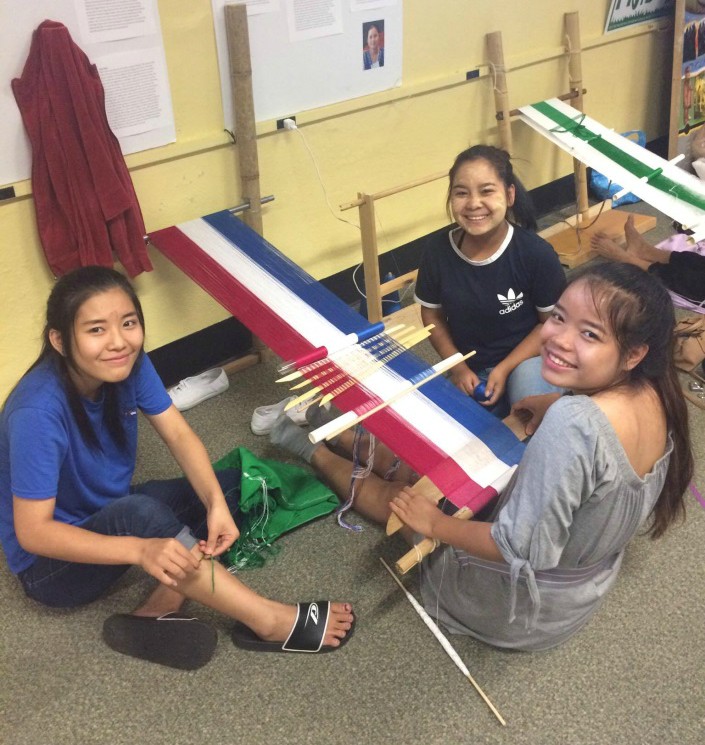
This Summer, as part of KOM’s Youth Program, women from the weaving circle taught a group of about 17 high school girls how to make traditional Karen woven clothing and bags. Our Youth Development Coordinators also led a youth dance class, where 20 Karen youth learned a traditional bamboo dance, which they performed at this year’s Martyr’s Day event.
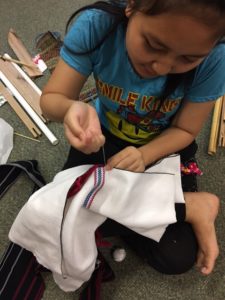 The youth weaving class met three times a week at the East Side Freedom Library for four weeks. For many of the students, this was their first time learning how to weave. One girl said, “Learning weaving is good for us, but it is hard, because this is my first time. If we mess up on one part, it takes an hour to fix it, but I have gained a lot of experience.”
The youth weaving class met three times a week at the East Side Freedom Library for four weeks. For many of the students, this was their first time learning how to weave. One girl said, “Learning weaving is good for us, but it is hard, because this is my first time. If we mess up on one part, it takes an hour to fix it, but I have gained a lot of experience.”
Besides just learning the skills and techniques that go into traditional Karen weaving, these young girls are learning valuable pieces of their Karen culture. Working side by side with experienced Karen weavers, these students can hear about the importance of weaving in their instructors’ lives in the Thai refugee camps and the importance of creating traditional Karen clothing.
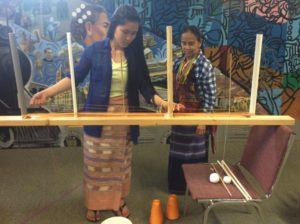 In the refugee camps, many Karen women became weavers to support their families through selling their products, including bags, shirts, dresses, scarves and more. Coming to the United States, these women see the importance of wearing Karen clothing so that others know who they are, where they come from and what culture they belong to. As one of the instructors in the weaving class, Shi Paw, said, “I want the new generation to keep our culture, even though we’ve been here [in the U.S.], we don’t want to forget our heritage. We want to represent our community that we belong to, so that wherever we go, people will know who we are.”
In the refugee camps, many Karen women became weavers to support their families through selling their products, including bags, shirts, dresses, scarves and more. Coming to the United States, these women see the importance of wearing Karen clothing so that others know who they are, where they come from and what culture they belong to. As one of the instructors in the weaving class, Shi Paw, said, “I want the new generation to keep our culture, even though we’ve been here [in the U.S.], we don’t want to forget our heritage. We want to represent our community that we belong to, so that wherever we go, people will know who we are.”
The interactions between the instructors and the students are encouraging. The women sit next to the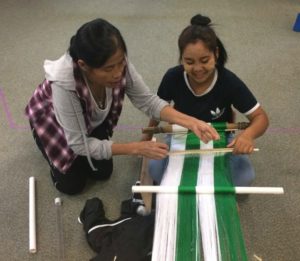 girls while they are working on their weaving projects and help them when needed. There is an atmosphere of openness and positivity as the high schoolers ask each other and the instructors for advice, opinions and help. Shi Paw said she is happy to work with these students because they really want to learn and keep their culture. She said, while some of the students are beginners and have learned simple patterns, she hopes they will come back to learn more complex patterns like flower petals. She also hopes that the program will continue, so that next year the more experienced students can come back to help the new students.
girls while they are working on their weaving projects and help them when needed. There is an atmosphere of openness and positivity as the high schoolers ask each other and the instructors for advice, opinions and help. Shi Paw said she is happy to work with these students because they really want to learn and keep their culture. She said, while some of the students are beginners and have learned simple patterns, she hopes they will come back to learn more complex patterns like flower petals. She also hopes that the program will continue, so that next year the more experienced students can come back to help the new students.
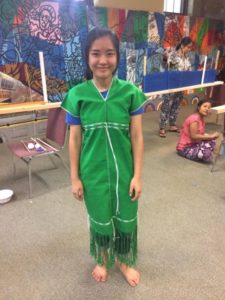 The youth have made women’s shirts, bags and dresses this summer. One of the students, Htee Moo Hser (pictured left), tried on her finished dress for the rest of the class to see.
The youth have made women’s shirts, bags and dresses this summer. One of the students, Htee Moo Hser (pictured left), tried on her finished dress for the rest of the class to see.
The students have been working on booklets that outline the weaving process in step by step instructions. Some of the students’ work will be on display at the Weaving Exhibit at the East Side Freedom Library for this year’s Saint Paul Art Crawl in mid-October.
All in all, the weaving class has been a success. One student says, “It is fun to come and learn about our culture. My mom supports me a lot in doing this.” One of our KOM Youth Coordinators, Pkwa Htoo, said, “For many of our students, after summer school is over they don’t have anything to do. When we called the parents to ask their permission for their teenager to participate in our weaving class, they were very happy.”

This activity is made possible by the voters of Minnesota through a grant from the Minnesota State Arts Board, thanks to a legislative appropriation from the arts and cultural heritage fund.
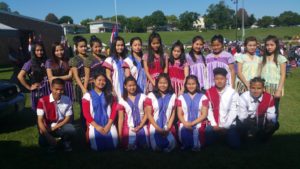
The youth dance class was also a success. The Karen students and the youth development staff met at First Baptist Church in downtown Saint Paul to practice three times a week for three weeks.
The Youth Dance class after performing at this year’s Karen Martyr’s Day ceremony on August 12th.
They decided to teach the students the traditional Karen bamboo dance, because, as youth coordinator Sarmoo Kwee says, you see a lot of Karen don dance performances, but not many bamboo dance performances. They want this culturally valuable dance to be passed on to the next generation. She said for this year they changed the song that goes with the dance to keep people interested. Along with changing the song, they had to adjust some of the choreography.
Other than learning the dance, Sarmoo said the students came to know each other better and learned how to work as a team. For the bamboo dance, she said, “one mistake costs everyone, so they have to work together in order to get it right.” The bamboo dance consists of half of the group holding bamboo sticks low to the ground so that they cross over each other in a checkered pattern, while the rest of the dancers step in between the spaces made by the crossed bamboo sticks. The ones holding the sticks clap the sticks together to the beat, so the dancers have to pay attention so as to not get their feet stuck between the bamboo.
The group performed wonderfully at the Martyr’s Day ceremony.


 (651)788-7593
(651)788-7593


